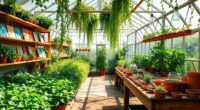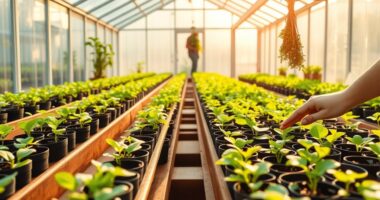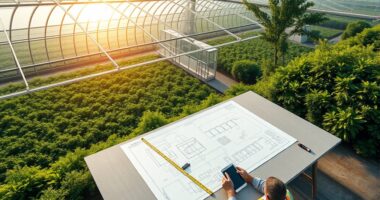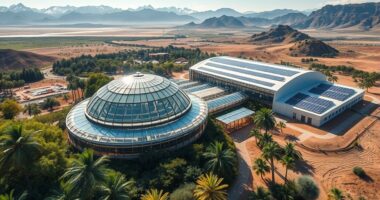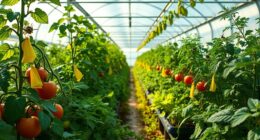The history and evolution of greenhouses show how humans have innovated in horticulture over centuries. You’ll see ancient Romans transforming gardens, medieval monasteries preserving agricultural knowledge, and Renaissance orangeries protecting delicate plants. The Industrial Revolution made glass accessible, while the Victorian era introduced intricate glasshouses. Today, smart greenhouses utilize technology to optimize growth. Sustainable practices also shape the future of greenhouse operations. There’s so much more to explore about this fascinating journey.
Key Takeaways
- Ancient Romans advanced greenhouse design with innovations like grafting and terracing, cultivating exotic plants in geometric gardens.
- Monasteries in the Middle Ages preserved agricultural knowledge, creating walled gardens for food and medicinal herbs.
- The Renaissance saw the emergence of orangeries, structures designed to protect citrus trees while symbolizing luxury and sophistication.
- The Industrial Revolution made glass affordable, leading to larger greenhouses showcasing exotic plants as status symbols in Victorian society.
- Modern advancements include hydroponics, smart greenhouse technology, and sustainable practices, enhancing efficiency and environmental impact.
Ancient Roman Innovations in Horticulture
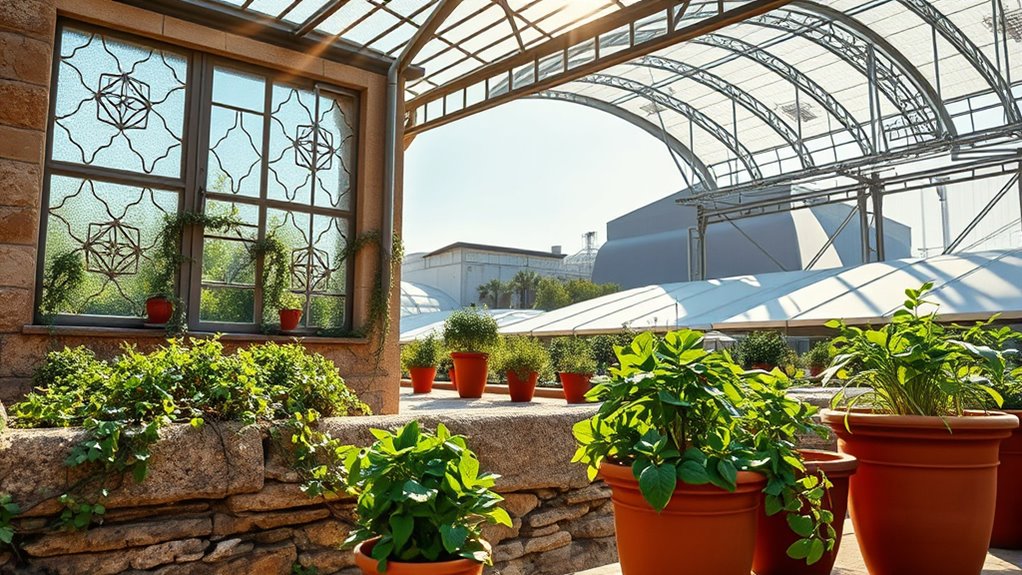
Although the ancient Romans drew inspiration from earlier civilizations, they markedly advanced horticulture through innovative techniques and designs.
The ancient Romans transformed horticulture with innovative techniques, blending inspiration from earlier civilizations with their own advancements.
You’d appreciate how Roman gardens flourished, attached to homes and public spaces, serving multiple purposes. They introduced exotic plants like cherries and peaches from military campaigns, transforming local landscapes.
Their horticultural techniques, including grafting and terracing, maximized space and productivity, fueling economic growth through market gardens and orchards.
The geometric layouts of gardens, with symmetrical designs and water features, enhanced both beauty and utility. With artistic sculptures adding to the ambiance, these gardens became essential social spaces.
Ultimately, Roman innovations laid a foundation for future horticultural practices, influencing gardening styles for centuries to come.
The Role of Monasteries in Medieval Gardening
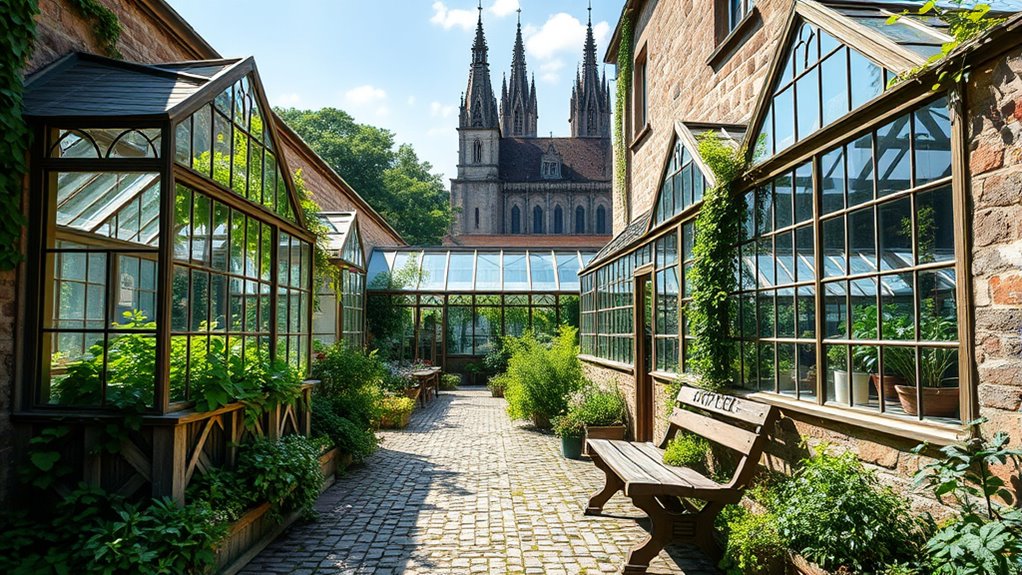
Monasteries played an essential role in preserving agricultural knowledge during the Middle Ages, ensuring that vital techniques survived through generations.
Their walled gardens not only protected delicate plants from harsh weather but also created sanctuaries for monks to cultivate both spiritually and physically.
Preservation of Agricultural Knowledge
During the Middle Ages, the preservation of agricultural knowledge was essential for the survival and growth of communities, and monasteries played a significant role in this process.
Monks cultivated gardens for food and medicinal herbs, becoming centers of healing and innovation. They documented their practices, ensuring that critical agricultural techniques were recorded for future generations.
The Rule of Saint Benedict emphasized self-sufficiency through gardening, while the Plan of St. Gall illustrated ideal garden layouts.
Figures like Hildegard von Bingen expanded the knowledge of plants, enhancing monastic gardens.
Through their efforts, monasteries not only supported their communities but also shared crucial agricultural insights, influencing local farming methods and laying the groundwork for modern practices.
Walled Gardens for Protection
As communities faced various external threats in medieval times, walled gardens emerged as crucial sanctuaries for both spiritual reflection and practical cultivation. Monasteries were pivotal in this development, crafting enclosed spaces that provided safety for plants and a serene atmosphere for monks.
These gardens, often arranged in symbolic quadrants, served multiple purposes:
- Protected plants from pests and harsh weather
- Supplied monks with food and medicinal herbs
- Symbolized earthly paradise and spiritual growth
- Preserved horticultural knowledge for future generations
With walls made from stone or hedges, these gardens became essential to monastic life, blending practicality with spirituality and offering a refuge for contemplation amidst the challenges of the outside world.
The Emergence of Orangeries During the Renaissance

During the Renaissance, orangeries emerged as elegant structures designed to protect delicate citrus trees from winter’s chill.
You’ll notice their grand windows and durable brick or stone construction, which not only maximized sunlight but also showcased the wealth of their owners.
These architectural marvels became essential elements in aristocratic gardens, blending functionality with sophistication.
Purpose of Orangeries
Orangeries emerged in the Renaissance as elegant structures primarily designed to house exotic citrus trees, reflecting the wealth and status of their owners.
These unique buildings served multiple purposes:
- Plant Protection: They safeguarded delicate plants from harsh weather, particularly frost.
- Social Gatherings: Orangeries became popular venues for feasts and parties, showcasing the owner’s affluence.
- Botanical Collections: They cultivated a range of exotic plants, from citrus to oleanders, enhancing botanical diversity.
- Symbol of Luxury: Growing fruit year-round was a rare luxury, symbolizing prestige and sophistication.
As you explore the history of orangeries, you’ll appreciate how they combined functionality and beauty, marking a significant evolution in horticultural practices and social dynamics of the time.
Design Features and Materials
While exploring the design features and materials of orangeries, you’ll discover that these structures were remarkable feats of engineering and artistry.
Typically built with wooden frames, they provided both strength and beauty. Large glass panels flooded the interiors with sunlight, showcasing advanced craftsmanship and promoting warmth. Their grand size and elegant designs symbolized wealth, blending functionality with the ornate style of the Renaissance.
Regional variations emerged in Italy, France, and England, each influencing the architectural style. Materials like stone, brick, and limited metalwork added stability and aesthetic appeal.
Improved glazing techniques enhanced insulation, while geometric layouts and water features harmonized with surrounding gardens, making orangeries a true reflection of art and nature combined.
The Impact of the Industrial Revolution on Greenhouse Design
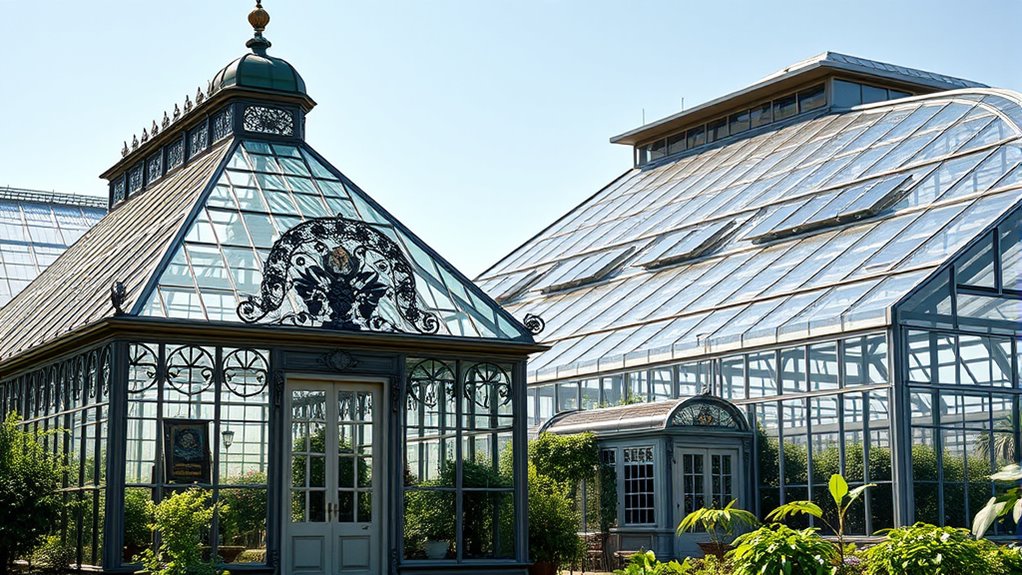
As the Industrial Revolution unfolded, it revolutionized greenhouse design by making glass more affordable and accessible than ever before. This shift allowed for widespread use of glass in greenhouses, enabling more people to explore horticulture.
With better materials, the design and functionality of greenhouses improved remarkably.
- Increased glass production led to larger structures.
- The demand for exotic plants fueled greenhouse expansion across Europe.
- Wealthy individuals sought greenhouses to showcase rare flora.
- Improved durability and maintenance with new frame materials emerged.
These advancements not only transformed gardening practices but also laid the groundwork for modern greenhouse technology, paving the way for innovative growing methods and efficient agricultural practices in the years to come.
Victorian Era Advancements in Glasshouse Construction
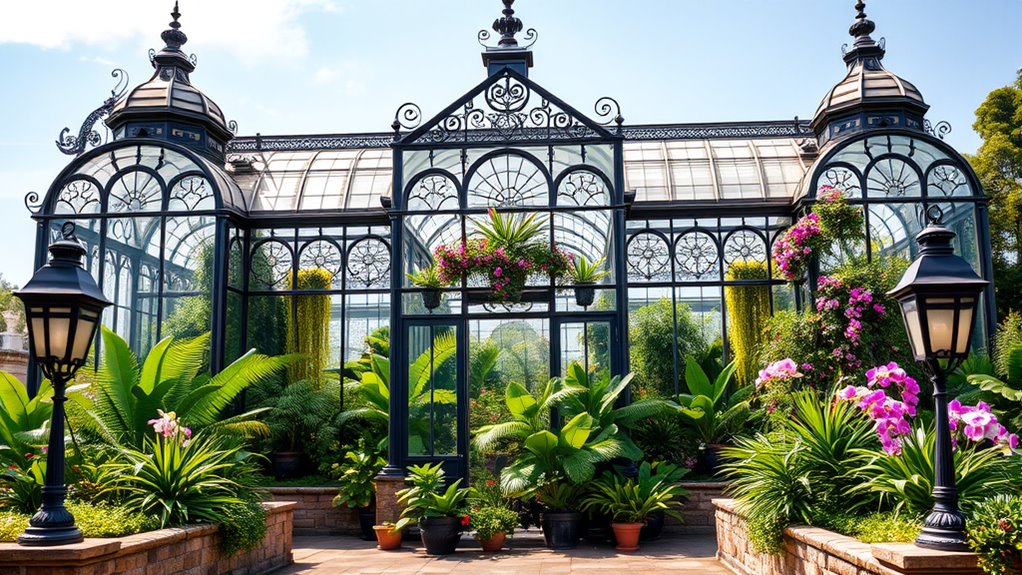
Victorian glasshouses emerged as a remarkable fusion of artistry and engineering, showcasing the period’s advancements in construction techniques.
These structures became status symbols, reflecting wealth through their intricate designs and high-quality materials. Innovators like Joseph Paxton pushed boundaries with cast iron frameworks that supported large glass panes, maximizing light for plant growth.
Peaked roofs and gable end doors not only added aesthetic charm but also improved functionality by retaining heat and enhancing ventilation. As botanical interest surged, these glasshouses served as centers for cultivating exotic plants, showcasing both affluence and scientific curiosity.
Gardening emerged as a popular pastime, with women actively participating in greenhouse gardening, and consequently, these glasshouses became integral to Victorian culture.
Early 20th Century Modernization of Greenhouses
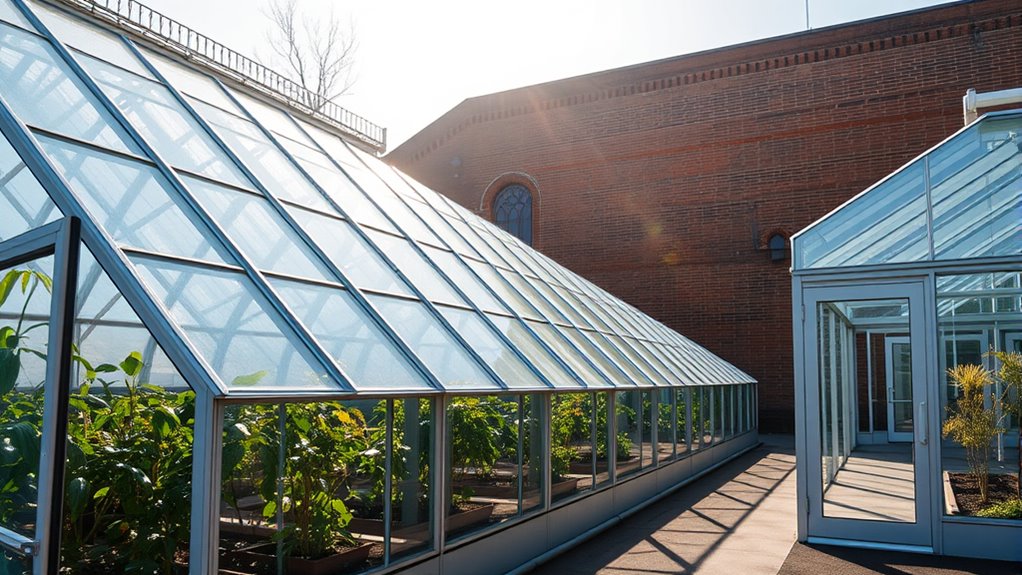
The evolution of greenhouses took a significant turn in the early 20th century, marked by modernization that embraced new materials and technologies. You’d find that aluminum frames replaced heavier iron and steel, while PVC pipes made greenhouses more affordable. Innovations like climate control systems and automated features enhanced efficiency, allowing for better plant growth.
- Lightweight materials improved construction and durability.
- Hydroponics gained traction, especially during World War II.
- Large-scale designs catered to increased food production.
- Sustainable practices began influencing greenhouse design.
These advancements not only made greenhouses more accessible but also set the stage for future innovations, transforming how we cultivate plants and produce food.
Late 20th Century Innovations in Greenhouse Technology
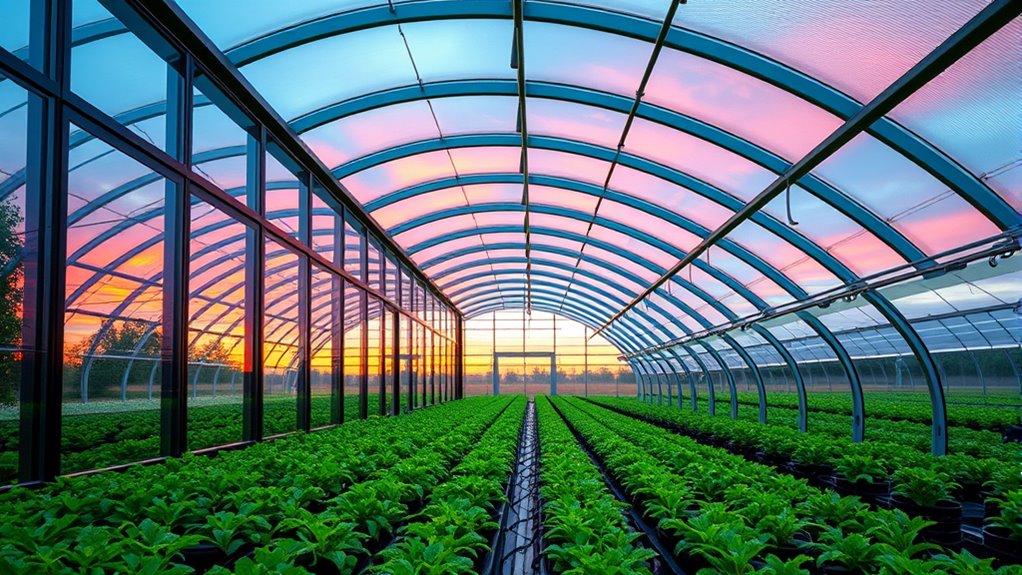
Innovations in greenhouse technology during the late 20th century transformed how we grow plants, making cultivation more efficient and sustainable.
You’ll find that polyethylene film, introduced in wider sheets, replaced glass, while UV inhibitors extended its lifespan. Lightweight aluminum frames became popular, alongside galvanized steel and PVC, lowering construction costs.
Geodesic domes and pyramidal designs emerged, enhancing aesthetic appeal and functionality. Advanced heating systems, automated ventilation, and energy-efficient designs improved climate control.
Hydroponics gained traction for soilless cultivation, maximizing yields. Eco-friendly materials like wood reentered the scene, and innovative practices like water conservation and passive solar designs minimized environmental impact.
Together, these advancements paved the way for a new era in greenhouse agriculture.
The Rise of Smart Greenhouses in the 21st Century
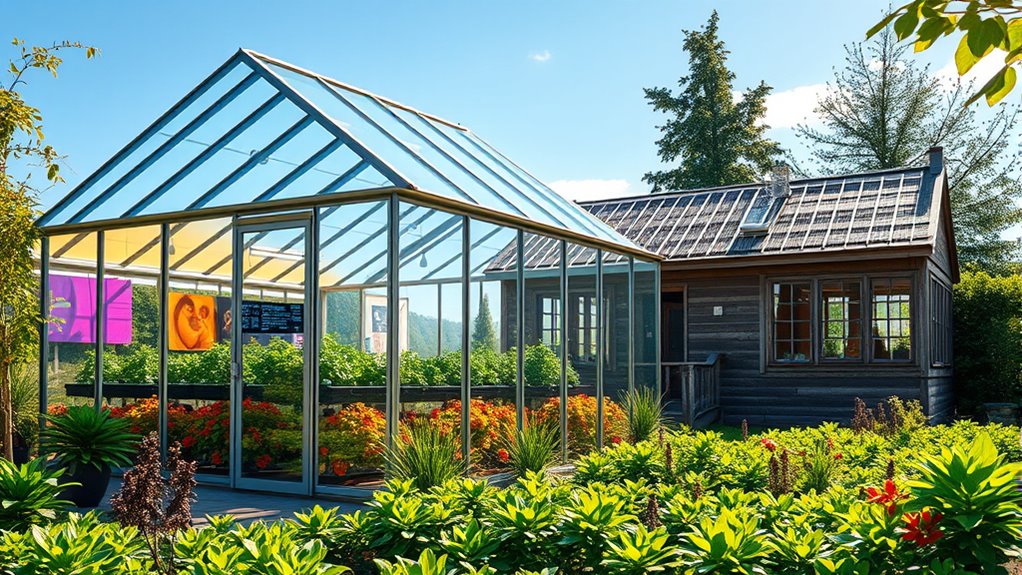
As agriculture faces increasing challenges from climate change and urbanization, smart greenhouses have emerged as a revolutionary solution for efficient and sustainable food production.
These innovative structures harness key technologies to optimize resource use and enhance crop health. You’ll find that:
- IoT and Sensor Technology deliver real-time data for precise control over growing conditions.
- Artificial Intelligence automates tasks like ventilation and lighting, predicting crop health.
- Automated Systems adjust settings based on current data, minimizing the need for human intervention.
- Data Analytics empower informed decisions on resource allocation and crop management.
With a projected market growth exceeding $4.5 billion by 2032, smart greenhouses are reshaping the agricultural landscape, emphasizing sustainability and efficiency.
Sustainability and the Future of Greenhouse Practices
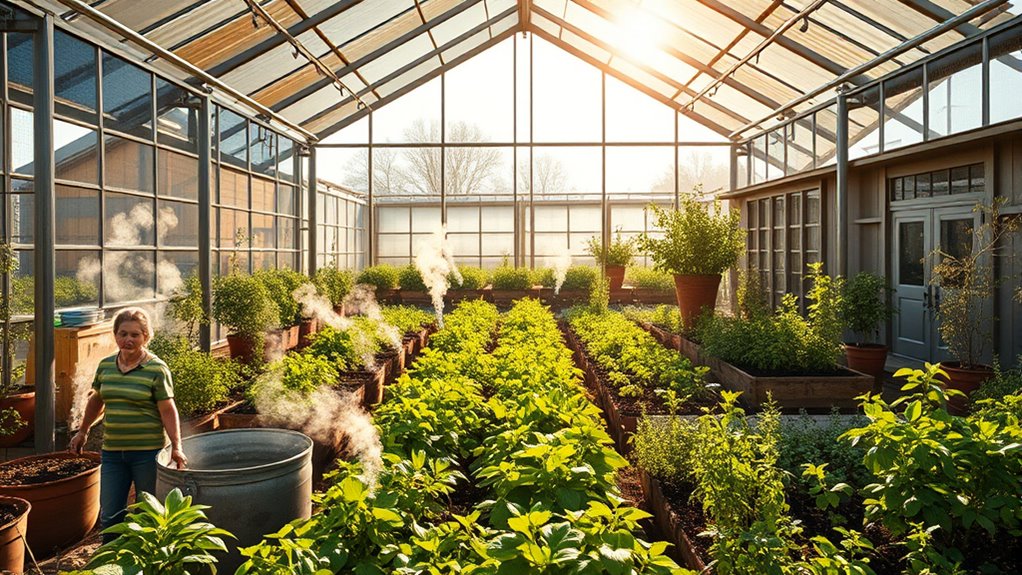
With a growing emphasis on environmental stewardship, sustainable greenhouse practices are becoming essential for the future of agriculture. You can embrace these practices by using recycled materials like reclaimed wood and polycarbonate panels in your greenhouse design.
Incorporate passive solar features to enhance energy efficiency and implement rainwater harvesting systems for irrigation. Utilizing thermal mass materials helps regulate temperature, while solar panels power your operation sustainably.
In your daily operations, practice composting, crop rotation, and integrated pest management to maintain soil health and reduce chemical use.
Efficient watering methods like drip irrigation and vertical gardening can maximize space. By adopting these innovative strategies, you’ll not only conserve resources but also contribute to community engagement and biodiversity enhancement.
Frequently Asked Questions
What Plants Were Commonly Grown in Ancient Greenhouses?
In ancient greenhouses, you’d commonly find cucumbers, herbs, and various vegetables.
They protected delicate plants from harsh climates, allowing for year-round cultivation.
Exotic plants brought back from tropical regions thrived in these early structures, while fruit trees like oranges and lemons were often overwintered.
Medicinal plants also found a home in these early greenhouses, showcasing the diverse range of flora that ancient gardeners nurtured in their quest for sustainability and beauty.
How Did Greenhouses Influence Food Production Throughout History?
Greenhouses have played a pivotal role in food production, with studies showing they can increase crop yield by 30% to 50%.
By providing a controlled environment, you can grow crops year-round, mitigating weather-related risks. This not only extends growing seasons but also enhances food availability and quality.
Additionally, greenhouses protect plants from pests and diseases, reducing the need for chemicals and improving sustainability.
In short, they’ve revolutionized how we cultivate food throughout history.
Were There Any Notable Greenhouse Architects in History?
When exploring notable greenhouse architects, you’ll find figures like Joseph Paxton, who designed the iconic Crystal Palace in 1851, showcasing innovative glasshouse architecture.
Another key name is J.C. Loudon, known for developing the ridge-and-furrow roof design, which improved greenhouse functionality.
Additionally, modern architects integrate sustainable materials and technology in their designs, pushing the boundaries of what greenhouses can achieve.
These contributions greatly impacted both aesthetics and functionality in greenhouse architecture.
How Have Greenhouse Aesthetics Evolved Over Time?
Greenhouse aesthetics have transformed like a chameleon, dazzling you with every era. From the elegant orangeries of the Renaissance, symbolizing wealth, to the modern smart greenhouses that blend technology with beauty, you’ll see a stunning evolution.
Today, eco-friendly designs made from sustainable materials captivate the eye and mind. As you explore these structures, you’ll appreciate their diverse applications, each reflecting a balance of artistry and functionality that’s simply breathtaking.
What Are the Environmental Impacts of Modern Greenhouses?
Modern greenhouses have both positive and negative environmental impacts.
On the plus side, they conserve water, enhance energy efficiency, and promote local cooling.
However, you should be aware of challenges like water overuse, plastic pollution, and soil degradation.
Intensive operations can also compete for local resources, affecting nearby communities.
Conclusion
As you explore the rich history of greenhouses, it’s clear that they’ve evolved to meet the changing needs of society. From ancient Roman innovations to today’s smart greenhouses, each advancement reflects our desire to cultivate efficiently. For instance, consider a modern urban farmer using a smart greenhouse with automated systems to optimize growth conditions year-round. This not only maximizes yield but also promotes sustainability, showcasing how the future of greenhouse practices can harmoniously blend technology and environmental stewardship.

